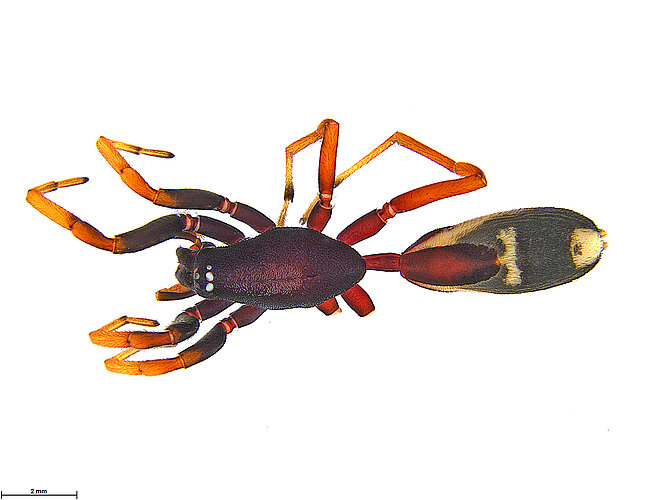Elongated White-tailed Spider Lamponina elongata Platnick, 2000
Fauna Portal species: 5293Diagnosis
(after Platnick 2000): Specimens of Lamponina elongata can easily be distinguished from those of the other known Lamponina species by their relatively long pedicel, their relatively narrow, elongated fourth femora, and (usually) their relatively pale coloration (the legs are usually yellow, and the anterior half of the abdomen is usually white). Males resemble those of L. scutata in having an oblique constriction at roughly half the length of the ventral surface of the palpal femur, but have a ventrally less protuberant retrolateral tibial apophysis. The female spermathecae are relatively long, and are often anteriorly divergent.
Status
- native
Linnean Holotype
Australia
- Northern Territory
- South Australia
- Victoria
- Western Australia
Fauna Portal Records
The map shows all records that have been verified as part of the Fauna Portal project and may not represent the true distribution of a species. Specifically, for described species, check the link to the Atlas of Living Australia on this page for potential wider distributions. Fauna Portal Reference specimens and Linnean types are shown in red. If you identified a specimen that exceeds the distribution of an undescribed species as illustrated here, please contact the Fauna Portal team who can assist with the lodgement of the specimen in a public institution and display on the map.
Publications
Platnick N.I. (2000): A relimitation and revision of the Australasian ground spider family Lamponidae (Araneae: Gnaphosoidea). Bulletin of the American Museum of Natural History. 245: 1 - 330
CATAAAGATATTGGAACTTTATATTTGATTTTTGGTTCTTGGGCAGCTATAGTAGGTACGGCTATGAGTGTTATGATTCGTATGGAATTAGGGCAATCTGGAAGATTGTTAGGTGATGATCATTTATATAATGTAATTGTAACTGCTCATGCATTTATTATAATTTTTTTTATAGTAATACCAATTTTGATTGGTGGTTTTGGAAATTGATTAGTACCATTAATGTTGGGGGCTCCTGATATAGCTTTTCCTCGAATAAATAATTTAAGATTTTGATTATTACCTCCCTCTTTAATTTTATTATTTATTTCTTCAATAGTGGAAATAGGGGTTGGAGCAGGGTGAACTGTATATCCTCCTTTGGCTAGAGTAATAGGACATTCTGGTAGTGCTATGGATTTTGCTATTTTTTCTTTACATTTGGCTGGTGCATCTTCGATTATAGGAGCTATTAATTTTATTTCTACTATTATTAATATACGTTCTATAGGAAT-AACTATGGAAAGGGTTCCTTTATTTGTATGATCTGTTTTAATTACAGCTATCTTATTATTATTATCTTTACCTGTATTAGCAGGAGCTATTACTATATTATTGACTGATCGAAATTTTAATACTTCTTTTTTTGATCCTGCTGGAGGAGGAGATCCTATTTTGTTTCAACATTTATTTTGATTTTTTGGTCAC
Araneae (Spiders)
- Actinopodidae
- Anamidae
- Araneae fam. indet.
- Araneidae
- Archaeidae
- Arkyidae
- Barychelidae
- Cheiracanthiidae
- Clubionidae
- Corinnidae
- Deinopidae
- Desidae
- Dictynidae
- Filistatidae
- Gnaphosidae
- Halonoproctidae
- Hersiliidae
- Idiopidae
- Lamponidae
- Linyphiidae
- Lycosidae
- Mimetidae
- Miturgidae
- Mysmenidae
- Nicodamidae
- Oecobiidae
- Oonopidae
- Oxyopidae
- Philodromidae
- Pholcidae
- Pisauridae
- Prodidomidae
- Salticidae
- Scytodidae
- Segestriidae
- Selenopidae
- Sparassidae
- Symphytognathidae
- Tetrablemmidae
- Theridiidae
- Thomisidae
- Trachelidae
- Trachycosmidae
- Trochanteriidae
- Uloboridae
- Zodariidae
- Zoropsidae
All classes
- Arachnida
- Crustacea
- Gastropoda
- Insecta
- Orthoptera - Caelifera (Grasshoppers)
- Hymenoptera excl. Formicidae (bees and wasps)
- Blattodea s. str. (Cockroaches)
- Coleoptera (Beetles)
- Dermaptera (earwigs)
- Diptera (flies, mosquitos)
- Entomobryomorpha (slender springtails)
- Hemiptera - Heteroptera (True Bugs)
- Hemiptera - Sternorrhyncha (aphids, scales etc.)
- Hemiptera - Auchenorrhyncha (cicadas, planthoppers)
- Hymenoptera - Formicidae (Ants)
- Trichoptera (Caddisflies)
- Zygentoma (silverfish)
- Myriapoda

